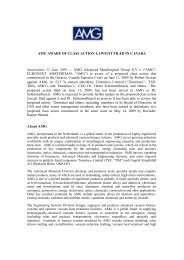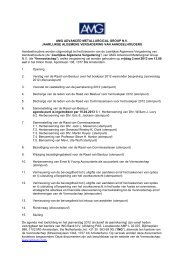C Si Ni Cr V Ti Ta Sc Li Sr Zr Fe Cu Zn Sn B Al Ce U Mn Mo Nb Sb
C Si Ni Cr V Ti Ta Sc Li Sr Zr Fe Cu Zn Sn B Al Ce U Mn Mo Nb Sb
C Si Ni Cr V Ti Ta Sc Li Sr Zr Fe Cu Zn Sn B Al Ce U Mn Mo Nb Sb
You also want an ePaper? Increase the reach of your titles
YUMPU automatically turns print PDFs into web optimized ePapers that Google loves.
Net realizable value is the estimated selling price in the<br />
ordinary course of business, less the estimated costs of<br />
completion and necessary selling expenses. The Company<br />
estimates the net realizable value of its inventories at<br />
least quarterly and adjusts the carrying amount of these<br />
inventories as necessary.<br />
Cost of inventories includes the transfer from other<br />
comprehensive income of gains and losses on qualifying<br />
cash flow hedges in respect of purchases of raw<br />
materials.<br />
(j) Deferred stripping costs<br />
Within the Company’s mining operations, advanced<br />
stripping costs incurred during the production stage of<br />
operations are recognized in prepaid inventory using<br />
the specific identification approach. This methodology is<br />
based on the variability of stripping costs over the course<br />
of a stripping campaign. The ability to strip the mine is<br />
largely seasonal. These amounts are included in prepaid<br />
expenses when the costs are directly attributable to a<br />
specific section of ore body that becomes accessible as a<br />
result of the stripping campaign. Amortization of<br />
the stripping costs into cost of goods sold occurs as the<br />
ore body, to which the stripping has been allocated,<br />
is processed.<br />
(k) Impairment<br />
(i) Financial assets<br />
A financial asset is considered to be impaired if objective<br />
evidence indicates that one or more events have had a<br />
negative effect on the estimated future cash flows of that<br />
asset. Financial assets are assessed collectively in groups<br />
that share similar credit risk characteristics.<br />
An impairment loss in respect of a financial asset<br />
measured at amortized cost is calculated as the<br />
difference between its carrying amount and the present<br />
value of the estimated future cash flows discounted at the<br />
original effective interest rate. <strong>Al</strong>l impairment losses are<br />
recognized in profit or loss.<br />
An impairment loss is reversed if the reversal can<br />
be related objectively to an event occurring after the<br />
impairment loss was recognized. For financial assets<br />
measured at amortized cost, the reversal is recognized in<br />
profit or loss.<br />
(ii) Non-financial assets<br />
The carrying amounts of the Company’s non-financial<br />
assets, other than inventories and deferred tax assets,<br />
are reviewed at each reporting date to determine<br />
whether there is any indication of impairment. If any such<br />
indication exists, then the asset’s recoverable amount<br />
is estimated.<br />
84 Notes to Consolidated Financial Statements<br />
For goodwill and intangible assets that have indefinite<br />
lives or that are not yet available for use, the recoverable<br />
amount is estimated at each reporting date.<br />
An impairment loss is recognized if the carrying amount<br />
of an asset or its cash-generating unit exceeds its<br />
recoverable amount. A cash-generating unit is the<br />
smallest identifiable asset group that generates cash<br />
flows that largely are independent from other assets and<br />
groups. Impairment losses are recognized in profit or<br />
loss. Impairment losses recognized in respect of cashgenerating<br />
units are allocated first to reduce the carrying<br />
amount of any goodwill allocated to the units and then to<br />
reduce the carrying amount of the other assets in the unit<br />
(group of units) on a pro rata basis.<br />
The recoverable amount of an asset or cash-generating<br />
unit or group of cash-generating units is the greater of its<br />
value in use and its fair value less costs to sell. In testing<br />
goodwill for impairment, the value in use is determined<br />
by the Company for the cash-generating unit or group<br />
of cash-generating units to which the goodwill has been<br />
assigned. However if tangible assets with a definite<br />
remaining useful life have to be tested for impairment<br />
and the value in use is below the corresponding carrying<br />
amount, a fair value less costs to sell methodology is<br />
utilized. Fair value differs from value in use. Fair value<br />
reflects the knowledge and estimates of knowledgeable,<br />
willing buyers and sellers. In contrast, value in use<br />
reflects the entity’s estimates, including the effects<br />
of factors that may be specific to the entity and not<br />
applicable to entities in general. Thus, in assessing value<br />
in use, the estimated future cash flows are discounted<br />
to their present value using a pre-tax discount rate that<br />
reflects current market assessment of the time value of<br />
money and the risks specific to the asset.<br />
An impairment loss in respect of goodwill is not reversed.<br />
In respect of other assets, impairment losses recognized<br />
in prior periods are assessed at each reporting date<br />
for any indications that the loss has decreased or no<br />
longer exists. An impairment loss is reversed if there<br />
has been a change in the estimates used to determine<br />
the recoverable amount. An impairment loss is reversed<br />
only to the extent that the asset’s carrying amount does<br />
not exceed the carrying amount that would have been<br />
determined, net of depreciation or amortization, if no<br />
impairment loss had been recognized.<br />
(iii) Associates and joint ventures<br />
After application of the equity method, the Company<br />
determines whether it is necessary to recognize an<br />
additional impairment loss on the Company’s investment<br />
in its associates and joint ventures. The Company<br />
determines at each reporting date whether there is any<br />
objective evidence that an investment in any associate or







